In this article, You will read the Geological Time Scale – for UPSC.
The Geological Time Scale
The geological time scale (GTS) is a system of chronological measurement that describes the timing and relationships between events that have occurred throughout Earth’s history.
Scientists developed the time scale by studying rock layers and fossils worldwide. Radioactive dating helped determine the absolute divisions in the time scale.
Applications
Illustrate the vast diversity of life that has been present on Earth over time.
Summarize how scientists study Earth’s past environment and diverse life-forms by examining different types of fossils
Explains how Earth’s history has been influenced by catastrophes that have affected the conditions on Earth and the diversity of its life-forms.
Divisions of Geologic Time
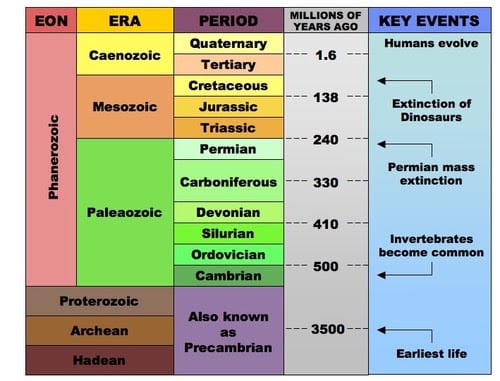
Geological time begins with Precambrian Time.
- PRE-CAMBRIAN – 88% of earth’s history
- Paleozoic (ancient life) – 544 million years ago, lasted 300 million yrs
- Mesozoic (middle life) – 245 million years ago, lasted 180 million yrs
- Cenozoic (recent life) – 65 million years ago, continues through present day. Today we are in the Holocene Epoch of the Quaternary Period of the Cenozoic Era.
PRE CAMBRIAN EON
- Started 700 million years before present.
- Earth changed from gaseous to the liquid state.
- Marine grasses evolved
- Soft-bodied invertebrate animals evolved in warm seas but land areas devoid of animals
Paleozoic Era (Ancient Life)
- The Cambrian period is the 1 st period of the Paleozoic Era.
- The explosion of life in the oceans began during this era.
- Most of the continents were covered in warm, shallow seas.
- Invertebrates were dominate
- Fish emerged during this time
- Fish led to the arrival of amphibians
- The end of the Paleozoic era is called the “Age of Amphibians”
- Early land plants including mosses, ferns, and cone-bearing plants.
- The early coal forming forests were also formed during this time.
Paleozoic Era
Much of the limestone quarried for building and industrial purposes, as well as
the coal deposits of western Europe and the eastern United States were formed
during the Paleozoic.
The Cambrian (beginning) opened with the breakup of the world-continent
Rodinia and closed with the formation of Pangaea, as the Earth’s continents came together once again.
- This event is thought to have caused the climate changes that led to the mass extinction events.
The Appalachian mountains were formed during this time.
At the end of the Paleozoic, the largest mass extinction in history wiped out approximately 90% of all marine animal species and 70% of land animals.
- Possible causes of this Mass Extinction Event
- Lowering of sea levels when the continents were rejoined as Pangaea (convergent boundary)
- Increased volcanic activity (ash and dust)
- Climate changes – cooler climate
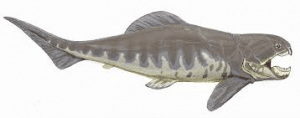
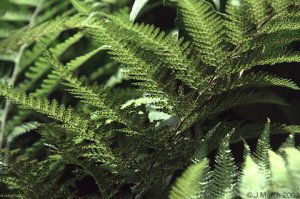
Mesozoic Era – Middle Life
- At the beginning of this era, the continents were joined as Pangaea.
- Pangaea broke up around the middle of this era.
- Reptiles became the most abundant animals because of their ability to adapt to the drier climate of the Mesozoic Era.
- Skin maintains body fluids
- Embryos live in shells
- Dinosaurs were also very active in this era.
- The first small dinosaurs appeared in the Triassic Period.
- Larger and more abundant dinosaurs appeared in the Jurassic Period.
- Small mammals and birds also appeared during this era.
- The mammals were small, warm-blooded animals. Hair covering their bodies.
- These characteristics help them survive in changing environments.
- The mammals were small, warm-blooded animals. Hair covering their bodies.
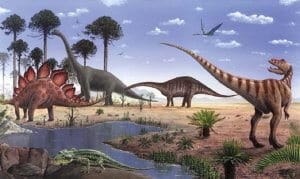
- The main plant life of this time were Gymnosperms or plants that produce seeds, but no flowers.
- Pine Trees
- Flowering plants appeared during the END of this era.
- This era ended with a mass extinction event about 65 million years ago.
- Many groups of animals, including the dinosaurs, disappeared suddenly at this time.
- Many scientists believe that this event was caused by a comet or asteroid colliding with the Earth.
Mesozoic Era – Mass Extinction Event
- Asteroid or Comet collides with Earth.
- Huge cloud of smoke and dust fills the air
- Blocks out sunlight
- Plants die
- Animals that eat plants die
- Animals that eat plant-eaters die.
- However, not all forms of life died during this event. Many animals that you see today are
descendants from the survivors of this extinction event.
Cenozoic Era – Recent Life
Began about 65 million years ago and continues today !!!!!
- Climate was warm and mild.
- Marine animals such as whales and dolphins evolved.
Mammals began to increase and evolve adaptations that allowed them to live in many different environments – land, air, and the sea.
- Grasses increased and provided a food source for grazing animals
Many mountain ranges formed during the Cenozoic Era
- Alps in Europe and Himalayas in India; Rocky Mountains in the USA
The growth of these mountains may have helped to cool down the climate
- Ice Ages occurred late in the Cenozoic Era (Quaternary Period).
As the climate changed, the animals had to adapt to the rise and fall of the oceans caused by melting glaciers.
This era is sometimes called the “Age of Mammals”
Marine animal examples:
- Algae, Mollusks, Fish and Mammals
Land animal examples:
- Bats, Cats, Dogs, Cattle and Humans
- Humans are thought to have appeared around 3.5 million years ago ( during the most recent period – Quaternary).
Flowering plants were now the most common plant life.
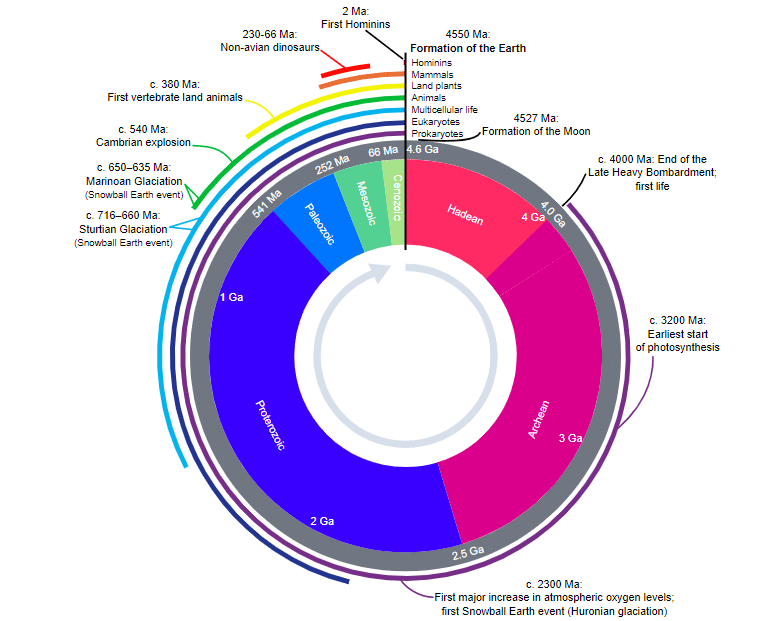
I will recommend you that you should refer google images for this article especially. Type every heading and topic in google search and see the related images.

Eagerly waiting for you to upload the entire notes. Easy to understand, Time saving and reliable
Nice…and easy to understand
Sir,Please start answer writing session for geography optional